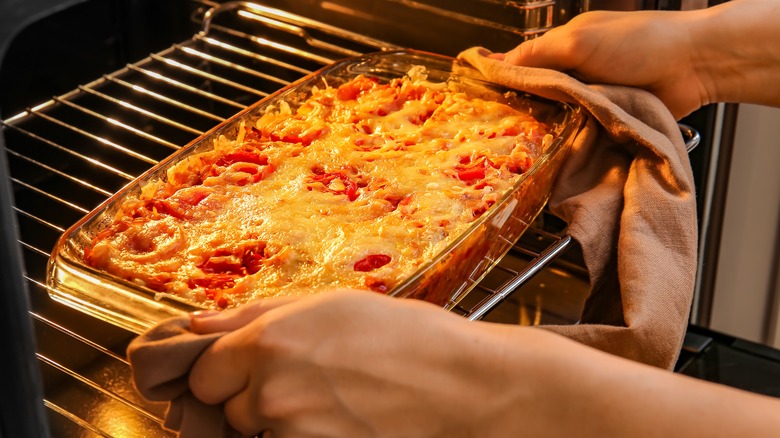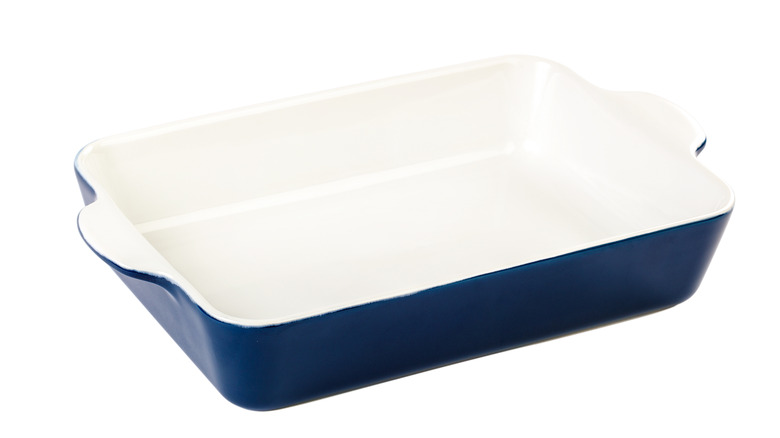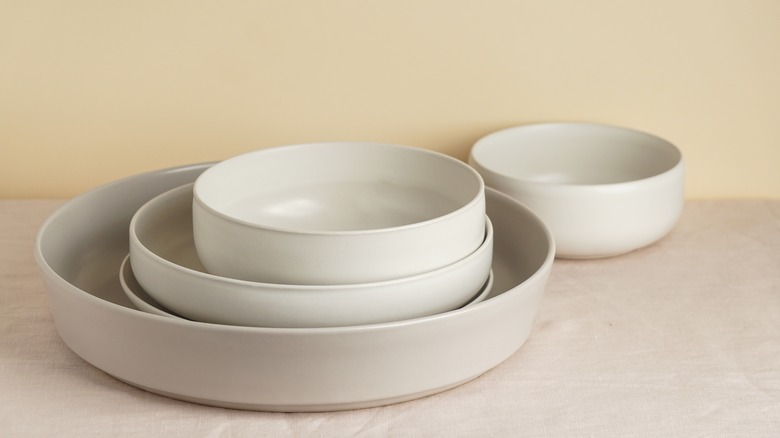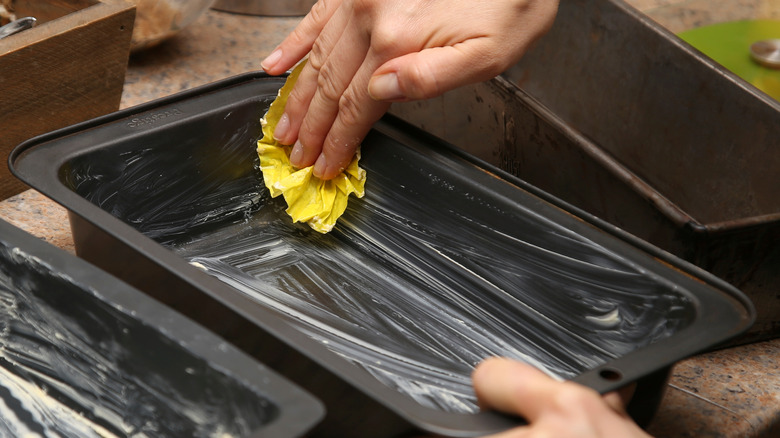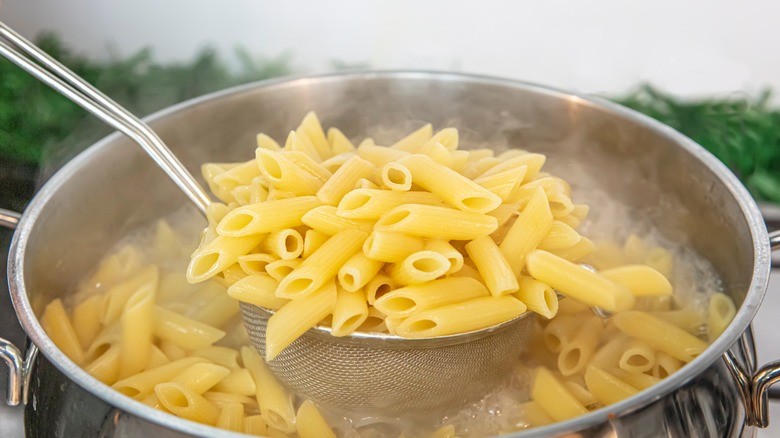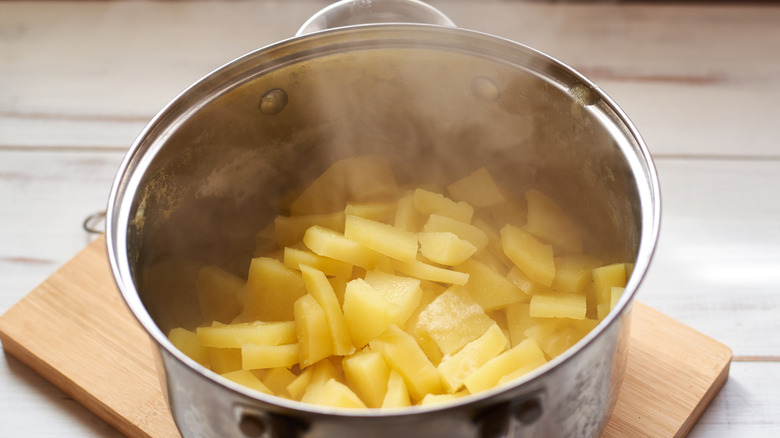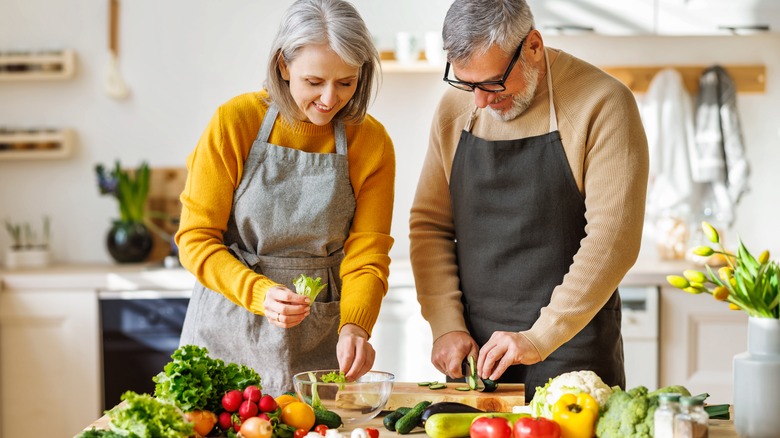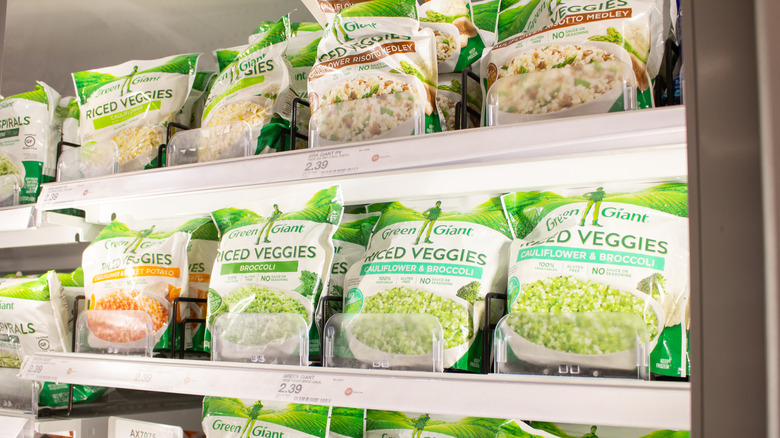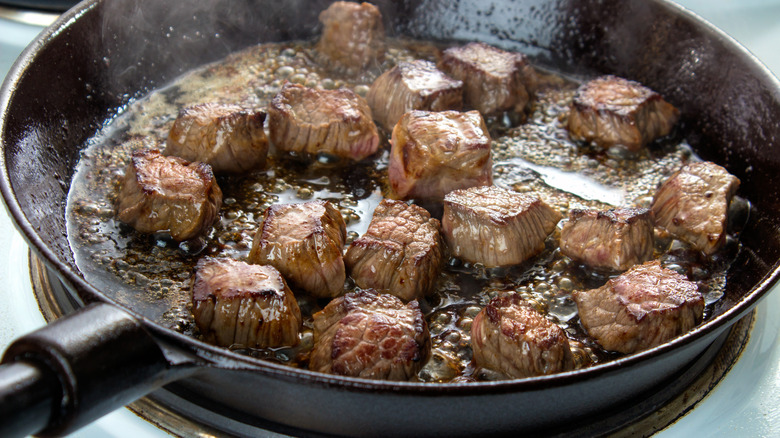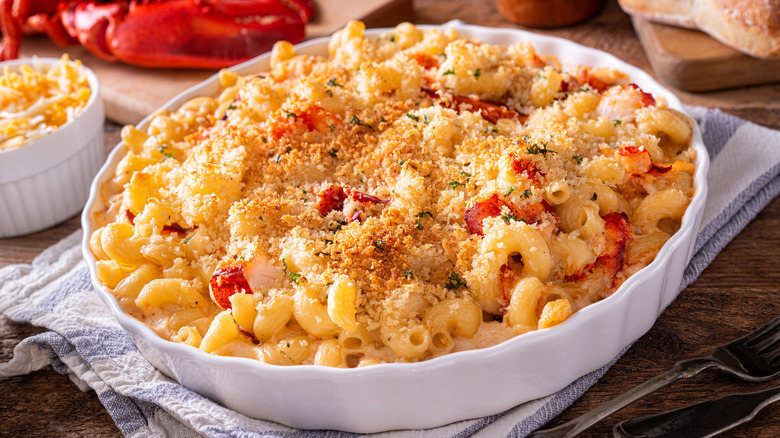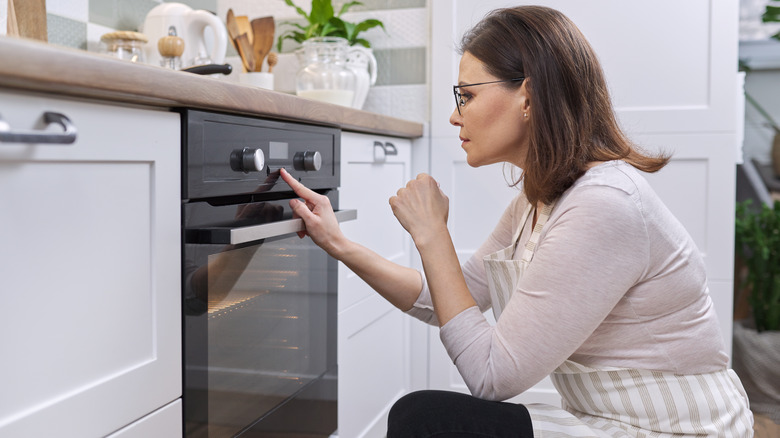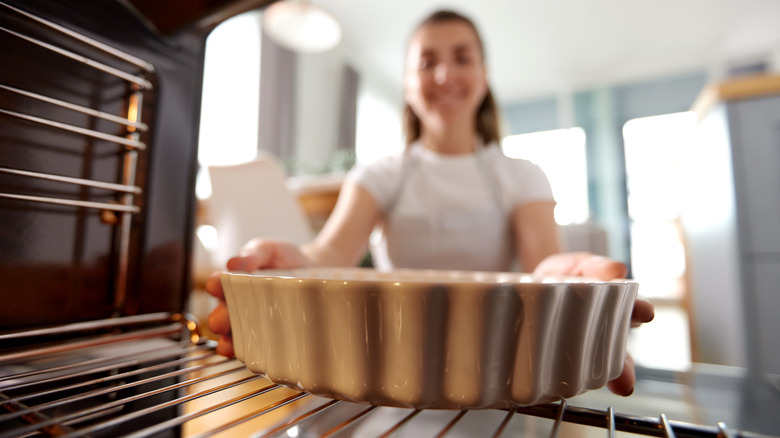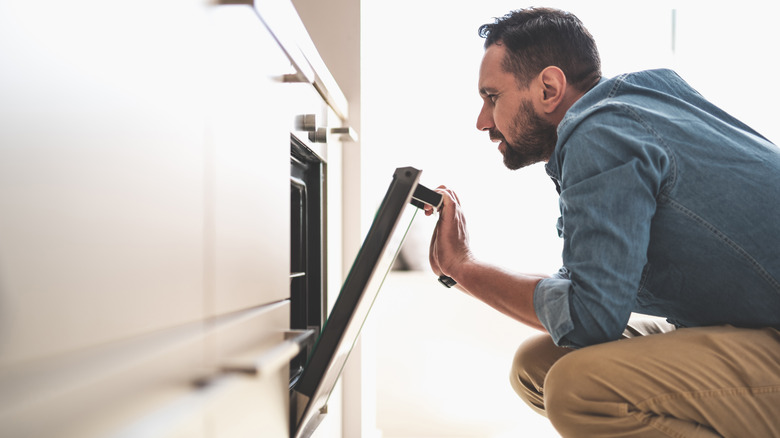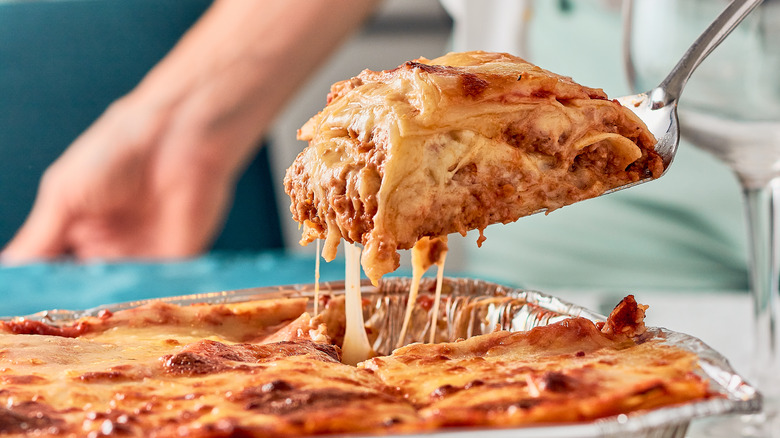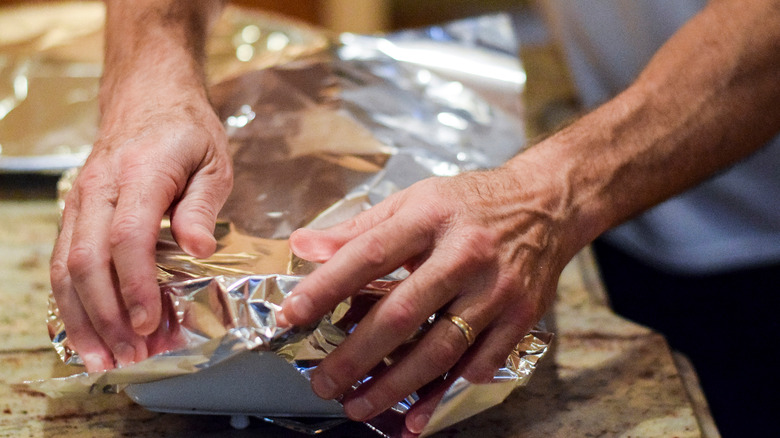14 Casserole Mistakes You Might Be Making (And How To Avoid Them)
Casseroles can make for a wonderful dinner. Because everything is cooked in the same dish, there is often less clean up after the meal to worry about compared to other meals. Casseroles can also make a hearty meal and are an excellent choice for cold, rainy, or snow days. With dishes like green bean casserole, taco pie casserole, cheesy corn casserole, and many others, there are quite a few different recipes to choose from, allowing you to add variety to your meal plan. If you have some extra ingredients or leftovers you need to use up, you can even come up with your own special casserole concoctions to cut down on food waste.
While most casseroles are relatively easy to make, there are some important things to keep in mind. If you avoid making the common casserole mistakes shared below, you'll be impressed by how better the flavor and texture of your casserole turns out. Read on so you can get into the kitchen and whip up a delicious meal to share with others.
Not using the right type of baking dish
A good casserole starts with the right baking dish. There are a few different things to consider when deciding what type of baking vessel to use when cooking a casserole. First, the dish you choose must be ovenproof. You likely have several baking dishes in your cabinet that meet this criterion, including ones made of cast iron, metal, glass, and ceramic.
Choose carefully, however. Metal pans heat up (and cool down) very quickly. After you remove the casserole from the oven, a metal baking dish will likely cool so fast that your casserole won't stay warm as long as you may want.
Instead, opt for a cast iron, glass, or ceramic vessel. These materials heat more gradually as your casserole bakes and also do a better job retaining heat, meaning your casserole stays warmer longer after it's been removed from the oven. Moreover, because these materials also heat more evenly, toppings should brown more evenly, too.
Not using the right size baking dish
In addition to making sure that the baking dish you choose is made from an ovenproof material that will heat evenly and retain heat, you also must make sure that it is not too small or too large for your baking needs.
When following a recipe, pay attention to what size pan is recommended for the casserole. If you're developing your own recipe, be sure not to overfill the baking dish. Leave some space on the top to account for bubbling in the oven and prevent the contents from overflowing when they cook.
If you'll be adding a topping to your casserole towards the end of the cooking process, you should also account for this when selecting the baking vessel. Even if you're confident that the pan you chose is the right size, place a sheet pan underneath the dish in the oven to help minimize clean-up.
Adding ingredients before greasing the pan
Don't add ingredients to the baking pan before greasing it. If you skip this step, when it comes time to serve the casserole, you may have trouble getting it out of the pan. If it does come out, there may be some pieces stuck to the bottom and each slice won't look presentable.
When it comes to greasing the pan, you can use cooking spray, oil, butter, or shortening. Consider the overall taste and flavor of the casserole when deciding which type of fat to use. Choose one that will complement the flavor, not negatively alter it. For example, you may want to avoid butter if you're making a healthier casserole as the butter flavor may end up being more noticeable — and out of place. Whatever type of fat you decide on, rub or spray it over the entire surface of the pan. Use a spoon to sprinkle a little flour over the pan, then flip the dish over to shake off the excess.
Overcooking pasta before adding it
Several casserole recipes call for macaroni, lasagna, or other types of pasta. If you're making a casserole with one of these ingredients, ignore the cooking directions on the box. Instead, it is important to undercook the pasta before adding it to the casserole, after which it will continue to cook in the oven. If it is already at the right texture and consistency before you mix it with the other ingredients, it will become overcooked once the casserole has finished baking. Casseroles with pasta that is overcooked can end up mushy and messy.
As a general rule, subtract two or three minutes from the cooking instructions printed on your pasta box. This will leave the pasta slightly firm when you combine it with the other ingredients in the casserole dish. The resulting casserole will be much more presentable and delicious when it's time to serve.
Assuming all vegetables will cook at the same speed
When making a casserole, it is important to remember that all vegetables do not cook at the same speed. Some, like broccoli and a few types of soft vegetables, will cook much more quickly than harder roots like carrots and potatoes. If you add in all of your vegetables raw at the same time, the resulting casserole will likely have a mixture of some veggies that are overcooked and others that are still hard — something nobody wants.
Instead, try par-cooking vegetables before adding them to your casserole. Par-cooking, or partially cooking the vegetables, can help ensure that the finished product is more evenly cooked for a more enjoyable dining experience.
Of course, because not all vegetables will cook at the same rate, you won't want to par-cook all the vegetables together. Par-cook carrots, potatoes, and other root vegetables longer than broccoli, zucchini, and other softer veggies. For hard produce, try putting it in the microwave for up to five minutes, while soft vegetables can just get blanched before you add them to the main casserole mixture. If your recipe calls for onions, be sure to sauté them to deepen their flavor and make sure your finished dish has a better taste.
Chopping your vegetables unevenly
Another secret to making sure that casserole vegetables cook properly and that the final dish has a good texture is to make sure that you cut the vegetables into even pieces. If you have some huge chunks of potato along with a few much smaller pieces, they simply aren't going to cook evenly. Either the bigger pieces will still be too hard once the casserole is finished cooking, or the smaller ones will be complete mush.
First, cut your vegetables on a cutting board using a sharp, high-quality knife. Don't try to eyeball it and cut things over the mixing bowl or pot.
Having evenly-sized vegetables will also make the casserole more enjoyable to eat. You don't want your guests to feel as if they need a knife to cut through some large pieces while also feeling like they can hardly taste others because they are so small. The casserole will also look more appealing when everything is uniform in size.
Adding frozen vegetables to your casserole
Adding frozen vegetables to a casserole is not always the wisest choice. Sure, opening a bag of vegetables and pouring them into your casserole dish with the other ingredients is easier than washing, cutting, and par-cooking fresh vegetables, but it can lead to less-than-desirable results. As the frozen vegetables cook inside the casserole, they will release moisture. The moisture can lead to a soupy, soggy casserole.
If you still want to add frozen vegetables to a casserole, don't pour them into the mixture while they are still frozen. Instead, place them in a colander and thaw them under cool running water. Once thawed, put the veggies on a paper towel or dishcloth. Pat them dry with another towel or dishcloth to remove as much moisture as you can before adding them to the casserole. You can also try pre-cooking the thawed veggies in a skillet for a few minutes to get rid of additional moisture.
Adding meat before browning it
One of the biggest mistakes you can make when following a casserole recipe is not browning the meat before adding it to the mixture. Yes, this will take a few extra minutes of your time and will leave you with a few more dishes to clean up, but it is well worth it. When you brown meat before adding it to a recipe, you're enhancing its flavor thanks to the Maillard reaction. When you add the meat to a medium-hot skillet, it will release some of its water and fat while the proteins break down and create browning, enhancing the overall taste and texture of the finished casserole.
You don't have to fully cook the meat to achieve this enhanced flavor. In fact, you don't want to. You typically only need to brown the outer layer of the meat because it will be baking more in the oven with the other ingredients. Fully cook it first and the meat may end up dry and overdone. Moreover, you want the meat to absorb the flavors of the other ingredients in the casserole, which is more easily done when the meat isn't fully cooked before joining the casserole.
Not adding a casserole topping
You don't have to add a topping to your casserole, but skipping this step could still be a big mistake. Toppings give a casserole's taste and appearance a nice upgrade. They often turn a lovely golden brown during the cooking process, while also adding a crispy and crunchy texture that will pair well with the softer texture of the rest of the dish.
There are many options to choose from when it comes to adding a topping to your casserole. Breadcrumbs are one of the more popular choices. You can make your own using some leftover bread, or simply grab a package of seasoned or plain breadcrumbs at the store. Larger panko breadcrumbs can add even more texture. If you want to try a different option, consider sprinkling fried onions, bacon crumbles, cheese, potato chips, or some combination of all four on top of your casserole.
Just remember that you shouldn't add the topping until you're ready to put the casserole in the oven. If you place it too far ahead of time, the ingredients will likely get soggy before they have a chance to bake. If you want an extra-crispy topping, consider waiting until the casserole has nearly finished baking. Add the toppings and then put the whole thing back in the oven under the broiler for a few minutes until everything is crisp and golden brown.
Choosing the wrong oven temperature
Be careful when setting the oven before you bake a casserole. If you choose a temperature that is too low, then obviously the ingredients will take too long to cook. The texture may be off as well. If you choose an oven temperature that is too high, the casserole will cook more quickly than expected and the ingredients may end up dry and overcooked.
Many casserole recipes will specify the correct oven temperature, which will take the guesswork out of the equation for you. However, if you are developing your own recipe, you'll need to choose an appropriate temperature on your own. As a general rule, most casseroles should be baked in an oven set between 350 and 400 degrees Fahrenheit. If your baking dish is very deep or you have raw or hard vegetables or meats in the mixture, 350 degrees is probably the best temperature to use. This will give the raw foods more time to cook evenly and prevent them from getting too dried out.
Putting the casserole in before preheating the oven
You also don't want to make the mistake of putting your casserole in the oven before preheating it. Preheating toned can vary depending on the oven and temperature you set. As a general rule, expect it to take between 12 and 15 minutes.
There are a few reasons why it is important to preheat an oven. First, the recipe you're following assumes the casserole will be placed in a hot oven. If you put your casserole in a cooler oven, it could change the required cooking time and may make it difficult to gauge when it has finished cooking.
Preheating the oven can also be an important step for food safety. If food spends too long out of the refrigerator without getting cooked, microbes on the surface can multiply. This growth is most likely to happen when the temperature of the food is in the between 40 degrees and 140 degrees Fahrenheit, as per the USDA. When you put your casserole in a preheated oven, it will begin cooking more quickly, allowing it to heat beyond the point of 140 degrees before it would have in a cold oven, adding an extra layer of food safety.
Opening the oven too frequently
We know. It can be tempting to open the oven to check on your casserole and especially when it's starting to look and smell delicious. However, doing this too frequently is a bad idea. Opening the oven door can allow heat to escape, which will naturally cause the temperature to drop. Not only will you be wasting energy when you open the door, but it can also slow down the cooking process.
But, you're only going to have the door open for a few seconds. What harm can it do, right? Well, you may be surprised to learn that opening the oven door, even for a short amount of time, can allow up to half of the heat inside the oven to flood out. So, resist the urge to open the oven until you think the casserole has finished cooking. If you want to peek at its progress, turn on the oven light — that's what it's there for.
Serving the casserole immediately
You've waited patiently for your casserole to cook, keeping the oven door closed, and now it is finally ready to take it out. That means it's time to cut into the casserole and serve it up now, right? Wrong. This is another time when you'll need to exercise some patience in the name of enjoying a better meal.
You might already know that many cuts of meat should be given time to rest before you dig in. The same is true for casseroles. When you remove a casserole from the oven, it's going to be very hot and bubbly. Giving it about 15 minutes to sit on the kitchen counter undisturbed will let those hot liquids cool and thicken just a bit. When you serve it, that slightly cooler temperature means that everything will be more settled and firm, making it easy to serve. If you try to dig into the casserole right away, it is likely to be a soupy mess that slops around on a plate. Moreover, with how hot everything will be, you also risk burning your tongue if you serve that casserole right away.
Not doubling the recipe to freeze portions
If you're not making double casseroles to freeze for easy dinners later, ask yourself: why not? You're already doing all the work of chopping up the veggies and combining ingredients, anyway. Doubling the recipe won't add much more work right away and will make for an incredibly simple dinner when you're ready to defrost and cook the casserole days or weeks later.
However, there are a few important things to keep in mind before you simply place a casserole dish in the freezer. First, be selective about the type of baking dish you use. Choose a sturdy material that can go from the refrigerator to the oven without cracking. Metal baking dishes and some glass dishes, such as Pyrex, can work well here. You can also grab a disposable aluminum foil pan from the grocery store so you won't have to worry about damaging your good baking dishes.
When freezing a casserole, first cover the top with plastic wrap. Then cover it again with at least one layer of aluminum foil to ward off freezer burn or contact with anything else that will change the flavor or texture of the dish. When you're ready to cook the casserole, give it at least one day to defrost in the refrigerator. Be sure to cook the casserole until the internal temperature reaches at least 165 degrees Fahrenheit to kill off many illness-causing pathogens, as per the USDA.
